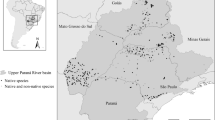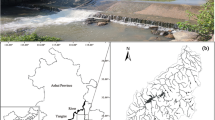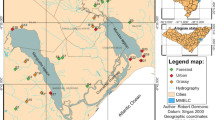Abstract
Identifying and explaining the pattern of how stream fish assemblages vary spatially are basic for the conservation and management of fish species diversity. Although low-head dams may facilitate the native invasions of generalist fishes to headwater streams, few studies have evaluated the impacts of the native invaders on indigenous fish assemblages. In this study, we collected 12 indigenous and 13 native-invasive fish species and measured physical habitats and dam dimensions from 62 impoundments of low-head dams located on headwater streams of the Qingyi River, China. We used linear regression and canonical correspondence analyses to evaluate how habitat and dam variables influenced native-invasive fish assemblages. Our results indicated that invasive fish species richness and abundance were related to elevation and upstream and downstream dam abundances, and their assemblage structures were influenced by substrate heterogeneity, dam height, and upstream and downstream dam abundances. We also used similar analyses to examine how habitat, dam, and invasive fish variables affected indigenous fish assemblages. Our results showed that indigenous fish species richness was correlated with substrate heterogeneity and dam height. However, indigenous fish assemblage structures were not only influenced by dam height, substrate, and downstream dam abundance, but also by invasive fishes. The abundance of one invasive species, Pseudorasbora parva, showed a strong negative influence on indigenous fish assemblages. Our study suggests that the combination of changes in abiotic factors and biotic structure and process following dam-building may determine the indigenous fish assemblages in the impoundments of low-head dams within headwater streams.


Similar content being viewed by others
References
Allan JD (2004) Landscapes and riverscapes: the influences of land use on stream ecosystems. Annu Rev Ecol Evol Syst 35:257–284
Angermeier PL, Winston MR (1999) Characterizing fish community diversity across Virginia landscape: prerequisite for conservation. Ecol Appl 9:335–349
Bain MB (1999) Substrate. In: Bain MB, Stevenson NJ (eds) Aquatic habitat assessment: common methods. American Fisheries Society, Bethesda, pp 95–103
Beyer K, Copp GH, Gozlan RE (2007) Microhabitat use and interspecific associations of introduced topmouth gudgeon Pseudorasbora parva and native fishes in a small stream. J Fish Biol 71:224–228
Britton JR, Davies GD, Harrod C (2010) Trophic interactions and consequent impacts of the invasive fish Pseudorasbora parva in a native aquatic foodweb: a field investigation in the UK. Biol Invasions 12:1533–1542
Buisson L, Grenouillet G (2009) Contrasted impacts of climate change on stream fish assemblages along an environmental gradient. Divers Distrib 15:613–626
Chen YY (1998) Cypriniformes II, Osteichthyes, Fauna Sinica. Science Press, Beijing
Chu XL, Zheng BS, Dai DY (1999) Siluriformes, Osterchthyes, Fauna Sinica. Science Press, Beijing
Carey MP, Sanderson BL, Barnas KA (2012) Native invaders – challenges for science, management, policy and society. Front Ecol Environ 10:373–381
Cumming GS (2004) The impact of low-head dams on fish species richness in Wisconsin, USA. Ecol Appl 14:1495–1506
Dodd HR, Hayes DB, Baylis JR et al (2003) Low-head sea lamprey barrier effects on stream habitat and fish communities in Great Lakes basin. J Great Lakes Res 29(Suppl 1):386–402
Eby LA, Fagan WF, Minckley WL (2003) Variability and dynamics of a desert stream community. Ecol Appl 13:1566–1579
Gauch HG (1982) Multivariate analysis in community ecology. Cambridge University Press, New York
Gillette DP, Tiemann JS, Edds DR et al (2005) Spatiotemporal patterns of fish assemblage structure in a river impoundment by low-head dams. Copeia 539–549
Godinho FN, Ferreira MT (1998) The relative influences of exotic species and environmental factors on an Iberian native fish community. Environ Biol Fish 51:41–51
Gozlan RE, Andreou D, Asaeda T et al (2010) Pan-continental invasion of Pseudorasbora parva: towards a better understanding of freshwater fish invasions. Fish Fish 11:315–340
Graf WL (2006) Downstream hydrologic and geomorphic effects of large dams on American rivers. Geomorphology 79:336–360
Harford WJ, McLaughlin RL (2007) Understanding uncertainty in the effect of low-head dams on fisher of Great Lakes tributaries. Ecol Appl 17:1783–1796
Helfrich LA, Liston C, Hiebert S et al (1999) Influence of low-head diversion dams on fish passage, community composition, and abundance in the Yellowstone River, Montana. River Res Appl 7:21–32
Helms BS, Werneke DC, Gangloff MM et al (2011) The influence of low-head dams on fish assemblages in streams across Alabama. J N Am Benthol Soc 30:1095–1106
Johnson PTJ, Olden JD, Vander Zanden MJ (2008) Dam invaders: impoundment facilitate biological invasions into freshwaters. Front Ecol Environ 6:357–363
Koga K, Goto A (2005) Genetic structures of allopatric and sympatric populations in Pseudorasbora pumila pumila and Pseudorasbora parva. Ichthyol Res 52:243–250
Konishi M, Takata K (2004) Size-dependent male-male competition for a spawning substrate between Pseudorasbora parva and Pseudorasbora pumila. Ichthyol Res 51:184–187
Krebs CJ (1989) Ecological methodology. Harper Collins, New York
Legendre P, Legendre L (1998) Numerical ecology, 2nd edn. Elsevier Science BV, Amsterdam, p 853
Lessard JL, Hayes DB (2003) Effects of elevated water temperature on fish and macroinvertebrate communities below small dams. River Res Appl 19:721–732
March JG, Benstead JP, Pringle CM et al (2003) Damming tropical island streams: problems, solutions, and alternatives. Bioscience 53:1069–1078
Matthews WJ (1998) Patterns in freshwater fish ecology. Chapman & Hall, New York
Meyer JL, Strayer DL, Wallace JB et al (2007) The contribution of headwater streams to biodiversity in river networks. J Am Water Res Assoc 43:86–103
Poff NL, Hart DD (2002) How dams vary and why it matters for the emerging science of dam removal. Bioscience 52:659–668
Porto LM, McLaughlin RL, Noakes DLG (1999) Low-head barrier dams restrict the movements of fishes in two Lake Ontario streams. N Am J Fish Manag 19:1028–1036
Poulet N (2007) Impact of weirs on fish communities in a piedmont stream. River Res Appl 23:1038–1047
Quinn JW, Kwak TJ (2003) Fish assemblage changes in an Ozark river after impoundment: a long-term perspective. Trans Am Fish Soc 132:110–119
Richter BD, Braun DP, Mendelson MA et al (1997) Threats to imperiled freshwater fauna. Conserv Biol 11:1081–1093
Rosenberg DM, Berkes F, Bodaly RA et al (1997) Large-scale impacts of hydroelectric development. Environ Rev 5:27–54
Rosenberg DM, McCully P, Pringle CM (2000) Global-scale environmental effects of hydrological alterations. Bioscience 50:746–751
Santucci VJ Jr, Gephard SR, Pescitelli SM (2005) Effects of multiple low-head dams on fish, macroinvertebrates, habitat, and water quality in the Fox River, Illinois. N Am J Fish Manag 25:975–992
Scott MC, Helfman GS (2001) Native invasions, homogenization, and the mismeasure of integrity of fish assmelbages. Fisheries 26:6–15
Schlosser IJ (1982) Fish community structure and function along two habitat gradients in a headwater stream. Ecol Monogr 52:395–414
Simberloff D (2011) Native invaders. In: Simberloff D, Rejmanek M (eds) Encyclopedia of biological invasions. University of California Press, Berkeley
Singer EE, Gangloff MM (2011) Effects of small dam on freshwater mussel growth in an Alabama (U.S.A.) stream. Freshw Biol 56:1904–1915
ter Braak CJF, Verdonschot PFM (1995) Canonical correspondence analysis and related multivariate methods in aquatic ecology. Aquat Sci 57:255–289
Tiemann JS, Gillette DP, Wildhaber ML et al (2004) Effects of lowhead dams on riffle-dwelling fishes and macroinvertebrates in a Midwestern river. Trans Am Fish Soc 133:705–717
Vannote RL, Minshall GW, Cummins KW et al (1980) The river continuum concept. Can J Fish Aquat Sci 37:130–137
Wang L, Infante D, Lyons J et al (2011) Effects of dams in river networks on fish assemblages in non-impoundment sections of river in Michigan and Wisconsin, USA. River Res Appl 27:473–487
Ward JV, Stanford JA (1979) Ecological factors controlling stream zoobenthos with emphasis on thermal modification of regulated streams. In: Ward JV, Stanford JA (eds) The ecology of regulated streams. Plenum, New York, pp 35–36
Warren ML, Burr BM, Walsh ST et al (2000) Diversity, distribution, and conservation status of native freshwater fishes of the southern United States. Fisheries 25:7–31
Winston MR, Taylor CM, Pigg J (1991) Upstream extirpation of four minnow species due to damming of a prairie stream. Trans Am Fish Soc 120:98–105
Wu XL, Zhong JS (2008) Gobioidei, Perciformes V, Ostichthyes, Fauna Sinica. Science Press, Beijing
Xiang XY (2011) Spatial and temporal patterns in fish assemblages of the Qingyi Stream watershed. Dissertation, Anhui Normal University, China
Yan YZ, Chen YF (2009) Variations in reproductive strategies between one invasive population and two native populations of Pseudorasbora parva. Curr Zool 55:56–60
Yan YZ, Wang H, Zhu R et al (2013) Influences of low-head dams on the fish assemblages in the headwater streams of the Qingyi watershed, China. Environ Biol Fish 96:495–506
Yan YZ, Xiang XY, Chu L et al (2011) Influences of local habitat and stream spatial position on fish assemblages in a dammed watershed, the Qingyi Stream, China. Ecol Freshw Fish 20:199–208
Yan YZ, Yan LL, Chu L et al (2012) Age, growth and reproduction of Zacco platypus in the Huishui Stream. Acta Hydrobiol Sin 36:474–481
Yang JX (1996) The alien and indigenous fishes of Yunnan: a study on impact ways, degrees and relevant issues. In: Peter JS, Wang S, Xie Y (eds) Conserving China’s biodiversity (II). China Environmental Science Press, Beijing, pp 151–168
Yu D, Chen M, Zhou Z et al (2013) Global climate change will severely decrease potential distribution of the East Asian coldwater fish Rhynchocypris oxycephalus (Actinopterygii, Cyprinidae). Hydrobiologia 700:23–32
Yue PQ (2000) Cypriniformes III, Osteichthyes, Fauna Sinica. Science Press, Beijing
Zhu R, Yan YZ, Sun JJ et al (2012) Feeding habits of fish assemblage in headwater streams of the Chencun Reservoir in Huangshan Mountain. Chin J Ecol 31:359–366
Acknowledgments
This study was supported by the Natural Science Foundation of China (31172120, 31372227) and National Basic Research Program of China (2009CB119200). We are grateful to two anonymous referees for their insightful advice on an earlier draft of this manuscript. This research was approved by the Anhui Normal University Animal Ethic Committee.
Author information
Authors and Affiliations
Corresponding author
Rights and permissions
About this article
Cite this article
Chu, L., Wang, W., Zhu, R. et al. Variation in fish assemblages across impoundments of low-head dams in headwater streams of the Qingyi River, China: effects of abiotic factors and native invaders. Environ Biol Fish 98, 101–112 (2015). https://doi.org/10.1007/s10641-014-0239-6
Received:
Accepted:
Published:
Issue Date:
DOI: https://doi.org/10.1007/s10641-014-0239-6




